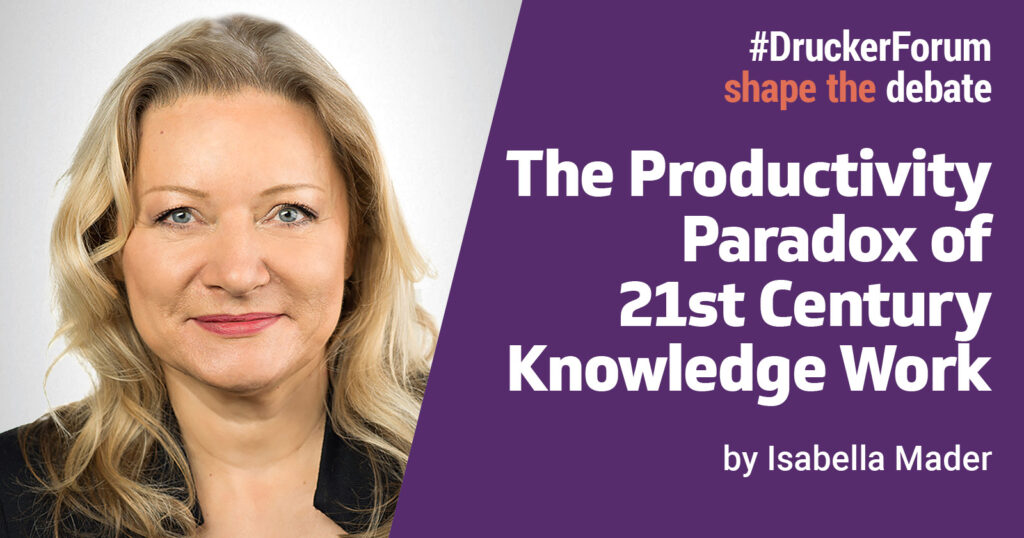
1994:
“Can I ask you something?”
“Sure! Great to see you! Come in, have a seat. Coffee?”
2024:
“Just a quick question…”
” Sorry, no time! Can you email me about it…?”
What happened? In his Management Challenges for the 21st Century, Peter Drucker noted that a key accomplishment of the 20th century was a fiftyfold increase in the productivity of manual labor. He predicted that the critical contribution of management in the 21st century would be to similarly enhance the productivity of knowledge work. Two decades into the 21st century, however, we are far from realizing this vision.
Where do we stand? Nobody has time, everyone is stressed if not exhausted or borderline burned out. We are drowning in information and communication overload, far from completing the obligatory reading in our in-tray, with massive backlogs building up. Few organizations today can claim to have unleashed the productivity of knowledge workers – with or without AI.
Productivity Pitfalls of Today’s Knowledge Work
Let’s first briefly assess the challenges.
Information overload. Today’s knowledge workers face an overwhelming volume of information and correspondence. Back in the 1970s, we were handling around 1,000 pieces of correspondence annually, primarily letters – an average of five every working day. By 2022, the volume had risen to 80,000 pieces of information a year, 80 times the volume of 50 years ago – an average of 121 emails, plus 226 work-related text messages a day on collaboration platforms and apps adding to the deluge. And the workforce has doubled in size since then.
Interruption culture. Knowledge workers face interruptions every three minutes on average, leading to significant time loss for regaining concentration that total up to 3 hours daily. Brace yourself: This means that 40% of every workday is wasted doing nothing. While we don’t need to get this down to zero – no one can concentrate for eight hours solid and we do need to answer questions from colleagues and clients – it is obvious that there is ample room for improvement here.
Search time. Despite technological advance, we still spend between 1-3 hours a day searching for information, a figure that hasn’t changed for 25 years – 25 years! – as the information torrent overwhelms our technological aids.
Reporting. Compliance and reporting have grown significantly in recent years, demanding extensive time and resources, in many cases adding little or no value: headcount goes up in unproductive areas.
Unproductive meetings. Unproductive meeting time wastes about an hour a day per person on average. Effective meetings are possible, but rare. Why?
Mass processing = knowledge-work drudgery. Tasks involving large amounts of repetitive activity, like tagging photos, handling mass inquiries or dealing with large volumes of text, should no longer be performed by human workers.
Productivity Pitfalls of Knowledge Work Can’t be Solved by AI Alone
Technology is part of the solution, but it comes down to management and behaviors to create meaningful change. Here are some suggestions.
Reduce interruptions. Discuss and agree among your team how to change information behavior, in particular how to respect others’ concentration time. Respect focus times in people’s diaries: Typically, 1-2 hours a day will be enough. Make information self-service: Improve documentation to reduce repetitive inquiries and enable workers to find information independently. This requires an initial “investment” by those burdened by interruptions. Consider using a Generative AI tool as a documentation assistant.
Improve search efficiency. Legacy search tools (e.g., in Explorer or SharePoint) often fail to deliver useful results in an acceptable time frame, and their makers are aware of this shortcoming. Therefore, consider Enterprise Search with AI: AI-driven search engines index your content and deliver search results much faster and more accurately than legacy search tools. Consider optimized software for this task rather than building solutions yourself.
Chat with your document. AI Summarizer tools like ChatPDF (as opposed to ChatGPT) and TLDRthis (or similar ones) create concise summaries and answer questions about document content, making it easier to deal with large volumes of reading and information.
Delegate mass processing to AI: Intelligent Document Processing (IDP) suggests solutions based on your own content like contracts, data, or large volumes of email and text.
Streamline reporting. Project-management software can be customized to handle reporting needs for collecting, consolidating, and analyzing Key Performance Indicators. Specialized software tools like IBM’s Envizi can help automate e.g. Environmental, Social and Governance or EU Corporate Social Responsibility Directive reporting, eliminating the need to manually update spreadsheets.
Enhance meeting efficiency. AI can summarize meetings, create minutes, and task lists. What it can’t do, however, is improve meeting culture. This is something that falls under the responsibility of management.
The Future of Productivity?
In an increasingly technology-dominated world, success will belong to those who can effectively manage both technology and human relationships, leveraging AI to boost productivity while maintaining the human qualities that drive lasting business success. Let’s reclaim the time for meaningful conversations with clients and colleagues, the time to solve a problem instead of postponing it, the time to generate new business, to expand our network by attending an interesting conference, or any other productive use of our human time and human intellectual capacity.
When Albert Einstein was asked why he set his students the same exam questions every year, he replied: “The answers have changed.” Similarly, in our quest to enhance the productivity of knowledge work, we must recognize that our methods must evolve. Simply working faster is not enough; we must work and manage differently.
About the author:
Bio: Isabella Mader is Executive Director of Excellence Research, university lecturer, author, and speaker. She has been teaching AI strategy for over 15 years.

